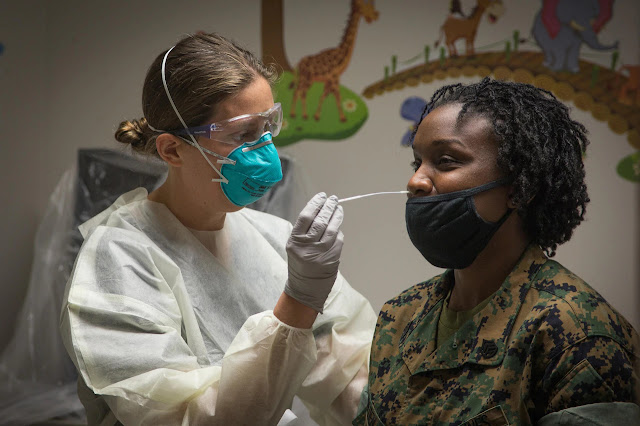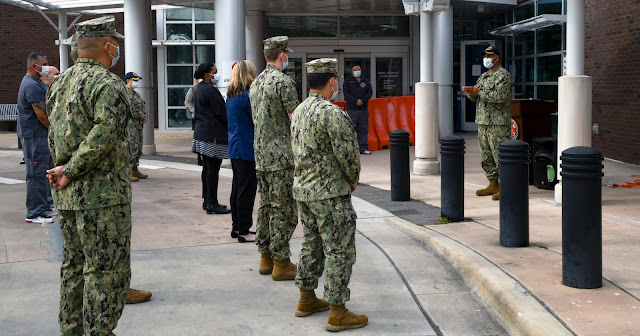Pandemic Provides Challenge, Opportunity to USU Tri-Service Nursing Team at Lejeune
By Vivian Mason
U.S. Army Major Melanie Owes and Air Force Major Bryan Hersch, both third-year Doctor of Nursing Practice (DNP)/Family Nurse Practitioner (FNP) students at the Daniel K. Inouye Graduate School of Nursing (GSN), Uniformed Services University (USU), were on rotations at Naval Medical Center Camp Lejeune, North Carolina, where they completed many of their clinical hours by working at the COVID and Acute Respiratory Clinic, as well as at the Family Medicine Clinic.
At first, Hersch and Owes weren’t quite certain how they were going to gain experience and complete their projects because most of the military facilities that permitted training limited inpatient appointments and were only doing virtual visits, except for the Emergency department and the COVID and Acute Respiratory Clinic.
Navy Cmdr. Robert Kimberling, the USU DNP Phase II site director, as Officer-in-Charge had only established the COVID and Acute Respiratory Clinic mere weeks before their arrival, and knew that it had an urgent need for more healthcare staff.
“That’s basically how we ended up at the clinic,” says Hersch.
| (Left to right) Maj. Bryan Hersch, Maj. Melanie Owes, and Cmdr. Robert Kimberling at the 11th Annual Naval Medical Center Camp Lejeune Research Day symposium. (Photo credit: Courtesy of Team Lejeune) |
The COVID and Acute Respiratory Clinic, an outpatient facility primarily staffed by nurse practitioners and physician assistants, evaluated people who presented with any kind of respiratory concern who needed to be seen by a provider, but who weren’t sick enough to go to the Emergency department. The clinic ensured that those patients quickly received the level of care they needed.
“We were able to screen patients for other conditions, like influenza or strep, treat them, and then send them home,” explains Owes. “We treated symptomatic patients, but we needed to protect other patients and staff from potential infection, too.
“Initially, individuals with any type of respiratory complaint were the only ones coming to the hospital for care. So, the clinic really evolved from primarily screening for respiratory complaints, including COVID, ear infections, shortness of breath, headache, coughs, gastrointestinal issues, etc. The respiratory clinic also accommodated outpatient pre-procedure testing, in-person visits, patients who had been seen at the Emergency department but who returned for other issues, and patients who needed an evaluation and/or reevaluation,” Owes said.
"In the clinic's 14-month existence, it saw more than 22,000 face-to-face patient visits without a single COVID case among its crew.” - Navy Cmdr. Robert Kimberling
Basically, the clinic served as an entry point for the hospital until the hospital eventually opened up for additional outpatient visits. It continues to operate to protect the sick from the well patients so that routine medical appointments can continue in the safest and most efficient manner possible.
A large part of the work performed by Owes and Hersch involved screening patients (“Have you been exposed to COVID? Do you have a cough? Have you been out of the area, etc.?”). They often screened for more than one thing because the clinic was tasked with handling all outpatient testing. The staff also took care of individuals needing pre-op clearance and close contact exposure. Almost all of the specimens were generated to ensure that testing was performed and ordered properly. The clinic served as a central point for all questions and follow-up. But, there was also a nurse-staffed COVID hotline for patients to call with questions.
“We tried to reassure the patients because we didn’t know if everyone was symptomatic,” said Hersch. “We emphasized the importance of patients not waiting until they were in distress to come in. If symptoms became severe, they were urged to call and talk to a professional.”
During their clinic assignment, Owes and Hersch worked with supervision because they were students. “We presented the patient and the case to our preceptors, who verified everything. We assisted with getting patients seen, as well as answered some of their basic questions,” said Owes. “We weren’t fully independent, but we helped off-lift some of the burden from staff.”
“Their contributions were absolutely essential to the success of the clinic. They were outstanding representatives of USU, the GSN, and their military services,” said Kimberling.
“The clinic formed a protective bubble that allowed routine chronic disease management and episodic care to continue in the safest way possible because it isolated the sick from the well while still maintaining social distancing with the strictest safety measures,” said Kimberling. “The staff became subject matter experts and were an integral part of the public health response and reporting for the region. In the clinic's 14-month existence, it saw more than 22,000 face-to-face patient visits without a single COVID case among its crew.”
Both DNP students found the respiratory clinic “an eye-opening experience.” It made them realize how good access to care is in some areas, compared to more rural areas of the country. “This is coastal North Carolina,” observed Hersch. “It’s a slower pace, and Jacksonville is surrounded by rural areas. The closest cities are at least a 40- to 50-minute drive away.”
“There was such a great distance for people to travel just to receive the care that they needed. There was only one hospital in Jacksonville that served the entire community and some rural areas. Having the respiratory clinic made me appreciate military medicine because I got to see how people really depended on our services and how valuable the care is that we deliver as part of the healthcare team,” said Kimberling. “It also helped me to understand the role that the nurse practitioner and physician’s assistant played in the delivery of healthcare.”
“We got to see a lot. Through screening, I discovered a patient with an HbA1c of 11.7. Even though she only came in for a COVID test, we found that her diabetes was out of control. Another patient had chest pains and had already been to the Emergency department. But her pain started up again as she walked to the respiratory clinic, and we found that her hypertension was out of control. Exposure to these kinds of health issues has been tremendously helpful,” Hersch said.
“Maj. Owes and I were trying to get as much experience as possible before we graduated. We also managed to obtain additional experience working in the Family Medicine and Obstetrics/Gynecology clinics. We want to be effective and hit the floor running when we start our new positions.”
Even though very involved with the Acute Respiratory Clinic, Owes and Hersch also diligently completed their Family Nurse Practitioner program scholarly research project titled “Examination of Syndromic Surveillance Data as a Trigger for an Alternate Care Facility in an Epidemic/Pandemic.” The project examined patient diagnoses, and data and business metrics to identify the best time to open and close an alternate care clinic. In the event that an outbreak occurred and reached epidemic- or pandemic-level spread, the information gives the Command objective data to help open a dedicated clinic while simultaneously protecting hospital staff and patients.
Their work at the COVID and Acute Respiratory Clinic recently concluded with their USU graduation. Owes completed her dual certification in the Family Nurse Practitioner and Women’s Health Nurse Practitioner programs. She’ll be working in a primary care clinic at Fort Bragg, North Carolina. Hersch completed his certification as a Family Nurse Practitioner and will be working in primary care at Wright-Patterson Air Force Base in Ohio.
“I think that the overall impact we had (as USU representatives) on the protective health measures for this region were simply amazing,” said Kimberling. “The safety record and numbers speak volumes about what the entire team accomplished. I'm very proud of the team's work.”
Both Family Nurse Practitioner students are thankful for this experience and look forward to using their education to take care of patients in need.






